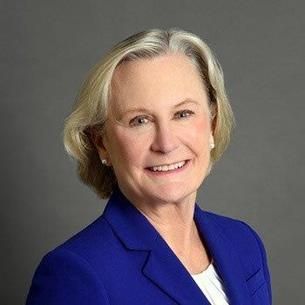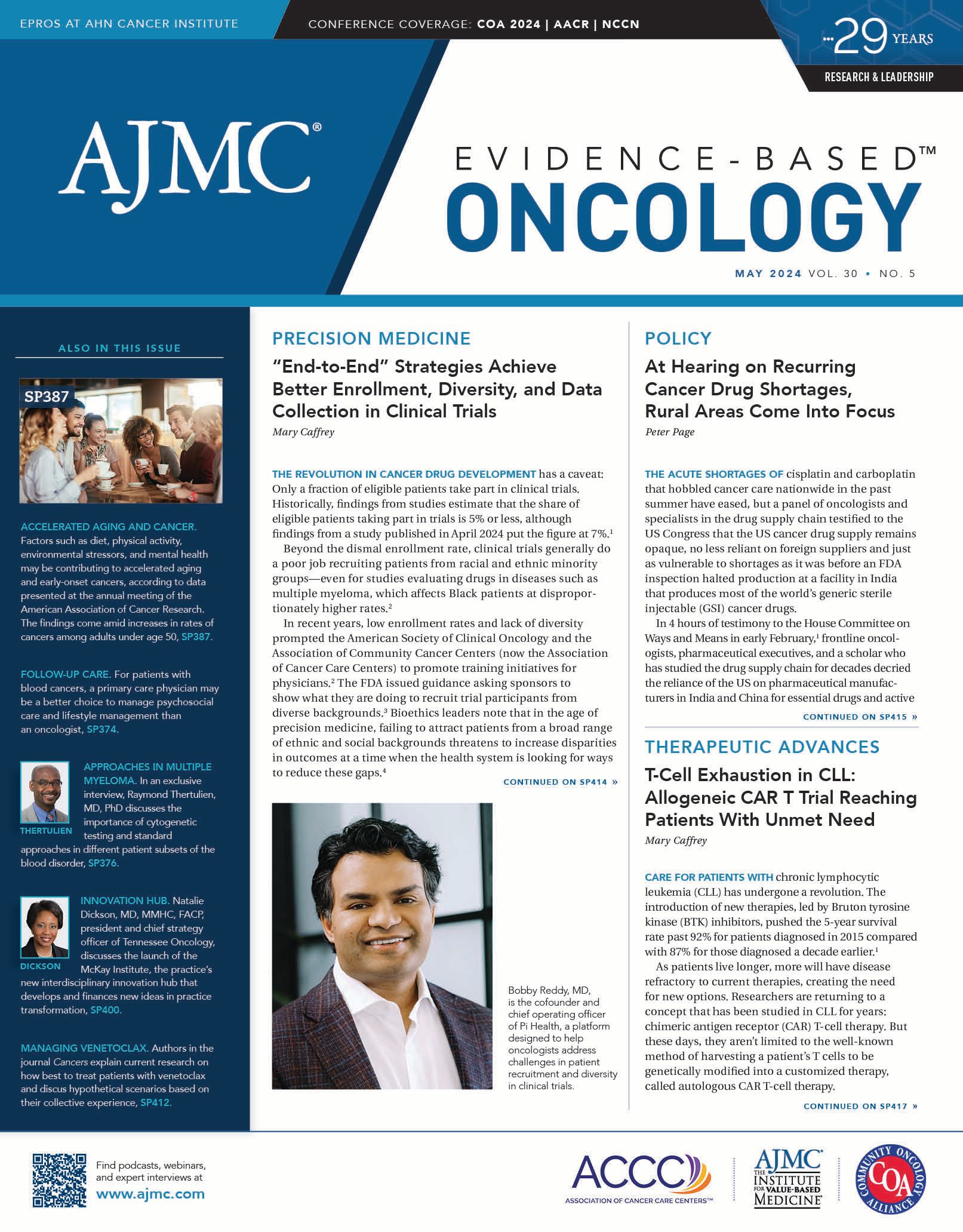- Center on Health Equity & Access
- Clinical
- Health Care Cost
- Health Care Delivery
- Insurance
- Policy
- Technology
- Value-Based Care
At Hearing on Recurring Cancer Drug Shortages, Rural Areas Come Into Focus
The acute shortages of cisplatin and carboplatin that hobbled cancer care nationwide in the past summer have eased, but a panel of oncologists and specialists in the drug supply chain testified to the US Congress that the US cancer drug supply remains opaque, no less reliant on foreign suppliers and just as vulnerable to shortages as it was before an FDA inspection halted production at a facility in India that produces most of the world’s generic sterile injectable (GSI) cancer drugs.
In 4 hours of testimony to the House Committee on Ways and Means in early February,1 frontline oncologists, pharmaceutical executives, and a scholar who has studied the drug supply chain for decades decried the reliance of the US on pharmaceutical manufacturers in India and China for essential drugs and active pharmaceutical ingredients (APIs) that has resulted in chronic and recurring shortages of key drugs, particularly GSIs.
Stephen Schleicher, MD, MBA | Image credit: Tennessee Oncology

“I implore Congress to take meaningful action to prevent further shortages of vital lifesaving cancer drugs and therapies needed to treat this life-threatening disease,” Stephen Schleicher, MD, MBA, said.
Schleicher, a medical oncologist, was then the chief medical officer for Tennessee Oncology, a large community oncology practice with 35 clinics and more than 200 oncologists who treat more than 100,000 patients each year.
Cancer Drug Shortages in Rural America
Members of the committee representing sprawling rural districts were well aware of the problems oncologists and pharmacists have obtaining essential drugs.
Rep Darin LaHood (R, Illinois), whose district spans 21 mostly rural counties across central and northwestern Illinois, detailed the struggles of Illinois CancerCare, a large community oncology practice in rural areas of his district, in obtaining midostaurin to treat 3 patients with acute illness. Midostaurin, a protein kinase inhibitor sold as Rydapt, is used for patients with acute myeloid leukemia, myelodysplastic syndromes, and other conditions.2
“The frustrations working with insurers for out-of-network suppliers have been significant,” LaHood said, before asking Schleicher whether there are “potential disparities” between rural and urban patients when seeking cancer drugs in short supply.
“Potentially yes,” Schleicher replied.
When cancer medications are in short supply, Schleicher said, rural oncology clinics unaffiliated with a hospital system—such as those operated by Tennessee Oncology—sometimes don’t get needed medications while the hospitals do.
“If hospitals get drugs, it means we will not if there is a limited supply,” Schleicher said. “We take all the uninsured patients in the state. One of our large hospital systems, which is 340B, doesn’t see uninsured or even Medicaid patients in the outpatient [setting]. If [they] weren’t to get those drugs, patients could not be treated near their homes or if they were uninsured.”
Schleicher referred to the 340B Drug Pricing Program, which allows hospitals that qualify as Medicare or Medicaid disproportionate share hospitals, children’s hospitals, or other safety hospitals to purchase drugs at deep discount from manufacturers while billing payers at usual rates.3 However, many of these hospitals are part of larger health systems that have extended the 340B purchasing power to all clinics.
Tennessee Oncology, under normal circumstances, treats approximately 170 patients using carboplatin and 50 patients using cisplatin per week, Schleicher said. At the worst stage of the supply shortage in mid-June 2023, there was a 2-week stretch when the practice only had sufficient medicines to treat 16 patients with carboplatin and 21 patients with cisplatin.
“We were unable to treat 90% of patients who required carboplatin and over 50% of patients who required cisplatin during that time,” Schleicher said. “There was an interval of over 10 days during which we did not receive any shipments of these medications, without any indication of when the supply would resume.”
“Keep in mind that we are one of the largest cancer treatment facilities in the country, including both independent practices and large hospital health systems, with significant purchasing power,” he continued. “Just imagine what smaller cancer treatment facilities, particularly those in rural America, must have faced.”
The Opaque Drug Supply Chain
The nation’s reliance on China for pharmaceuticals was a major concern during the hearing.
Rep Jodey Arrington (R, Texas), who is also chair of the House Budget Committee, cited results from a survey of the health care facilities in his district, which found 86% of cancer treatment centers reported dealing with cancer drug shortages.
“Retail pharmacists in West Texas said 40% to 50% of the calls they receive daily are inquiries about the availability of a drug the caller can’t get in their own community,” Arrington said.
“A pharmacist in Abilene, [Texas], informed my office that of the 10 medications he dispenses the most, 60% were made in China, and over half of all the medications he dispenses are made in China. He compounds drugs, and [he] estimated [that] of 100 ingredients in their lab, 90 are from China.”
Julie Gralow, MD, FACP, FASCO | Image credit: ASCO

Julie Gralow, MD, FACP, FASCO, chief medical officer and executive vice president of the American Society of Clinical Oncology, noted a “severe problem with transparency” in the pharmaceutical supply chain, particularly the sources of APIs. The FDA, she said, only learned after it shut down the Intas plant in India for severe quality control problems, triggering the acute shortage of cancer GSIs, that it is also a major source of APIs.
“A more robust supply chain would require a better early detection system—what comes from where—for early notification of a problem to allow a more effective response,” Gralow testified.
Stephen Schondelmeyer, PharmD, PhD, director of the PRIME Institute at the University of Minnesota College of Pharmacy in Minneapolis, noted that the US federal government keeps close track of farm products but “no single agency of the US government knows the complete status of the drug supply at any given time.”
Schondelmeyer is active with the End Drug Shortages Alliance, whose 281 participants include may large pharmaceutical companies and 27 hospitals and health systems. The group monitors closely for early signs of drug shortages and has a rapid response team tasked with gathering and publishing information to help alliance members respond more effectively.
“[The] FDA has been somewhat cooperative but has said they can’t officially share information with us or sit on the rapid response team,” he said, before encouraging Congress to authorize the FDA to share information.
Can a Lifesaving Drug Be Too Cheap?
Testimony to the committee made clear that although the official topic was drug shortages, the real problem is the recurring shortages of GSIs, which are inherently more complex to produce than generic medications in pill form. About two-thirds of drug shortages are for GSIs, and the most common reason for the shortage is a plant shutdown to deal with a quality control problem.
The root cause of GSI shortages, Gralow said, is that market forces have driven the prices too low for manufacturers to turn a profit. Securing a reliable supply of GSIs will require paying prices that are adequate to create incentives for process improvements and stringent quality control, which are unaffordable for manufacturers at current prices, she added.
“We are going to have to pay more money for these sterile injectable drugs, which often cost less than this bottle of water, but in exchange we will get resiliency across the system and good quality manufacturing,” Gralow said. She noted that more than half of cancers diagnosed in the US are in patients 65 years or older, which has resulted in Medicare being the largest single purchaser of cancer drugs in the United States.
“So Medicare can play a big role in how we strengthen these sterile injectables that are dirt cheap,” Gralow said.
Allan Coukell, senior vice president of public policy at Civica Rx, a nonprofit generic drug company created by US health systems and philanthropies to address drug shortages, testified about what he called the Civica model. Civica, he noted, delivers more than 80 drugs chosen by US hospitals because they are at risk of shortage and has delivered more than 150 million containers over the past 5 years. Key features of the Civica model are as follows:
- Long-term purchase and supply contracts that add stability to the market
- Direct contracts with hospitals rather than through middlemen, which may contribute to price and supply instability
- Maintaining approximately 6-month buffer inventory of every drug
US sourcing whenever possible, with the European Union and Canada as second choices - Avoiding China for finished drugs or API if there is an alternative source
- Intensive quality oversight of suppliers
- A single cost-plus price available to every purchaser
Coukell cited findings from a study in The New England Journal of Medicine that found health systems that procured drugs from Civica realized net cost savings.4
The standard drug procurement system based on pharmacy benefit managers only values price, Coukell said. “The system is driving toward 1 thing, low cost, and not valuing resiliency of the supply chain, so we have to switch those incentives,” he said. “That would allow the Civica model to expand and grow but also for other entities to step in with similar practices.”
Waiting for Congress to Act
There is bipartisan support for taking action on solving the cancer GSI problem. Over the 4-hour hearing, no witness or committee member had anything good to say about the current GSI supply chain, and both Democrats and Republicans on the committee are aware of the problem from constituent complaints. A hearing on December 5, 2023, before the Senate Committee on Finance resulted in a joint effort by Senate Finance Committee Chairman Ron Wyden (D, Oregon) and ranking member Mike Crapo (R, Idaho) to a write bipartisan health care plan to resolve the perennial problem of GSI shortages.5 They contained their ideas in a white paper, now circulating in Congress.
Gralow expressed hope that with the cancer focus of the Biden administration, the information presented at the House hearing, and the previous hearing before the Senate Committee on Finance, there is momentum to reform the system.
“The administration has brought the issue attention, and now maybe we will be able to fix a problem that has been going on for more than a decade,” she said.
Nicolas Ferreyros, managing director of policy, advocacy, and communications for the Community Oncology Alliance (COA), was less hopeful. He praised the white paper by Senate Committee on Finance staff as “a serious document” that includes ideas from the COA but expressed doubts that even a well-grounded bill with abundant bipartisan support can pass the current Congress.
“You have to wonder whether we’re going to have any real long-term fix here or whether we’re just going to find ourselves in the same situation in 10 years,” Ferreyros said. “Congress is so broken right now that even good ideas aren’t forward. I am often wrongly characterized as a pessimist, but I am a realist by practice. And I understand that, especially in an election year, doing something like this, even though it’s the right thing, is pretty challenging.”
References
1. Hearing on Examining Chronic Drug Shortages in the United States; US House Committee on Ways and Means, 118th Cong (2024). February 6, 2024. Accessed April 8, 2024. https://bit.ly/3vLVP3L
2. Midostaurin. FDA. Updated April 28, 2017. Accessed April 8, 2024. https://www.fda.gov/drugs/resources-information-approved-drugs/midostaurin
3. Overview of the 340B Drug Discount Program. Congressional Research Service. October 14, 2022. Accessed April 8, 2024. https://crsreports.congress.gov/product/pdf/IF/IF12232
4. Dredge C, Scholtes S. Vaccinating health care supply chains against market failure: the case of Civica Rx. NEJM Catal Innov Care Deliv. 2023;4(10). doi:10.1056/CAT.23.0167
5. Wyden, Crapo release plan to prevent and mitigate generic drug shortages. News release. US Senate Committee on Finance. January 25, 2024. Accessed April 8, 2024. https://bit.ly/4avQVqL
6. Preventing and Mitigating Generic Drug Shortages: Policy Options Under Federal Health Programs. US Senate Committee on Finance. January 25, 2024. Accessed April 8, 2024. https://www.finance.senate.gov/imo/media/doc/white_paper_preventing_drug_shortages.pdf

Trends in Hospital Pricing for Vulnerable Emergency Department Users, 2021-2023
December 4th 2025Self-pay emergency department prices rose significantly from 2021 to 2023, especially at for-profit and system-affiliated hospitals, highlighting growing affordability challenges for uninsured and underinsured patients.
Read More
